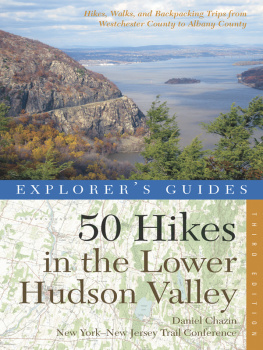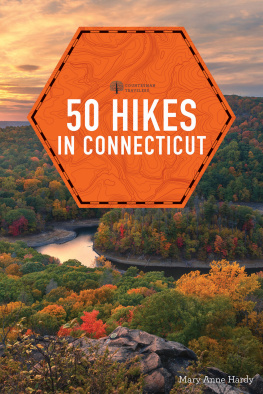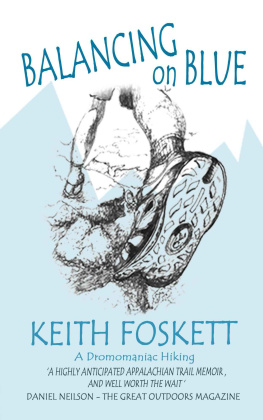50 Hikes in Eastern Pennsylvania
50 Hikes
In Eastern Pennsylvania
From the Mason-Dixon Line to
the Poconos and North Mountain
Fifth Edition
TOM THWAITES and the KEYSTONE TRAILS ASSOCIATION

AN INVITATION TO THE READER
Over time trails can be rerouted and signs and landmarks altered. If you find that changes have occurred on the routes described in this book, please let us know so that corrections may be made in future editions. The author and publisher also welcome other comments and suggestions.
Address all correspondence to:
Editor, 50 Hikes Series
The Countryman Press
P.O. Box 748
Woodstock, VT 05091
Copyright 2012 by Thomas T. Thwaites and the Keystone Trails Association
Copyright 1982, 1989 by Carolyn Hoffman
Copyright 1977, 2003 by Thomas T. Thwaites
Fifth Edition
All rights reserved. No part of this book may be reproduced in any way by any electronic or mechanical means, including information storage and retrieval systems, without permission in writing from the publisher, except by a reviewer, who may quote brief passages.
ISBN: 978-0-88150-997-7
Explorers Guides 50 Hikes in Eastern
Pennsylvania
Cover and interior design by Glenn Suokko
Maps by Richard Widhu and Mapping Specialists Ltd., Madison, WI
Published by The Countryman Press, P.O. Box 748, Woodstock, Vermomt 05091
Distributed by W.W. Norton & Company, Inc., 500 Fifth Avenue, New York, NY 10110
Printed in the United States of America
10 9 8 7 6 5 4 3 2 1
For Thurston Griggs (19162011)
for his many years of service to foot trails
in Pennsylvania and Maryland.
50 Hikes in Eastern Pennsylvania at a Glance



CONTENTS
Acknowledgments
Many of the hikes in this book were suggested by employees of the Pennsylvania Bureau of State Parks, the National Park Service, the Pennsylvania Bureau of Forestry, and members of the Keystone Trails Association.
I thank Oreste Unti, Tom Davidowski, John Seville, Ron Gray, James Becker, James Flandreau, Mike Cosgrove, Erik Williams, Larry Pittis, Joe and Lorraine Healey, Matt Marcinek, Tom Scully, Mark Arbogast, Steve McGuire, Karen Lutz, Carl Lorence, Marty Smith, Norm Lacasse, and many others whose names I didnt get or forgot to write down. I am particularly grateful to my wife, Barbara, who served as hiking companion, driver, typist, and editor.
Introduction
Hiking is a particular delight to me. Every season there are new things to discover, even on the same old trail. Wildflowers of spring give way to the soft green velvet beauty of summer, which in turn gives way to the color riot of autumn, followed by the snows of winter, with their many animal tracks.
All of us return to the roots of our species when we walk. Our ancestors were bipedal long before they were human. They walked out of the jungle into the veldt and then all over the earth. As an anthropologist would say, bipedalism (walking on two feet) preceded encephalization (swelling of the brain). Our cousins who persisted in walking on their knuckles are still in the Gombe Preserve.
Nessmuck wrote: We do not go to the woods to rough it, we go to smooth it. We get it rough enough in town. Nessmuck is the pen name of George Washington Sears (182190), Pennsylvanias pioneer conservationist and outdoor writer.
Climb the mountains and get their good tidings. Natures peace will flow into you, and the storms their energy, while cares drop off like autumn leaves, is the way John Muir put it.
According to Thomas Jefferson, Walking is the best possible exercise. Habituate yourself to walk very far. The Europeans value themselves on having subdued the horse to the uses of man: but I doubt whether we have not lost more than we have gained, by the use of this animal.
And as Aldo Leopold said, Never did we plan the morrow, for we had learned that in the wilderness some new and irresistible distraction is sure to turn up each day before breakfast.
Hiking in eastern Pennsylvaniadespite our regions proximity to the cities along the coasthas much to offer. North Mountain is still wild and remote; the Poconos shelter the most secure portion of the states bear population; the famous Appalachian Trail follows South and Blue Mountains across Pennsylvania. Saint Anthonys Wilderness, just 20 kilometers north of Harrisburg, is the second largest wild area in the state. Although the state forests are smaller than average, there are many state parks and game landssome quite largeas well as lands of some public utilities open to the public. A national recreation area and two national historic parks round out the roster. Public lands are limited in extent in eastern Pennsylvania, but well developed with trails.
Trails may traverse woodlands or follow old canals and roads, but many are multiuse, with bicycle and horse as well as foot traffic. On multiuse trails you must pay attention to the rights-of-way of the different trail users. Since horses are easily startled and may throw their riders (sometimes with fatal results), both hikers and bicyclists should give way to horses. Bikers should in turn give way to hikers.
While some trails are heavily used, on others you can still find solitude and a sense of remoteness. There are views, waterfalls, canals, streams, a Civil War battlefield, ghost towns, water gaps, and old railroad grades, as well as quiet paths through the woods and through the largest city park in the world.

The author on footlogs
GEOGRAPHY
Eastern Pennsylvania contains all the geographic provinces of the state, save one (the Lake Erie Lowlands). These include the Allegheny Plateau and the Ridge and Valley Province. Then, moving from Blue Mountain at the edge of the Ridge and Valley region toward Philadelphia, come the Great Valley; South Mountain and the Reading Prong; the Triassic Lowlands; the Piedmont; and the Coastal Plain.
The Pocono Mountains are a southern extension of the Allegheny Plateau, which consists of broad uplands cut by deep, narrow river valleys. The Ridge and Valley Province is made up of wide valleys separated by sharp, narrow ridges. The Allegheny Front forms the boundary between these two regions.
All the other regions lie in the lower right-hand corner of the state. The Great Valley extends from Georgia to New York State; in Pennsylvania it is formed of Cambrian and Ordovician rocks. South Mountain and the Reading Prong are made of Precambrian rocks. The Reading Prong is famous for its radon gas. The Triassic Lowlands were formed when the ancient supercontinent of Pangaea started to break apart about 200 million years ago. The Piedmont is made of a complex of metamorphic rocks of Paleozoic and Precambrian age. The Coastal Plain is of Cretaceous age and cuts across Philadelphia. Look in Van Divers Roadside Geology of Pennsylvania for a map of these different regions.
Next page










